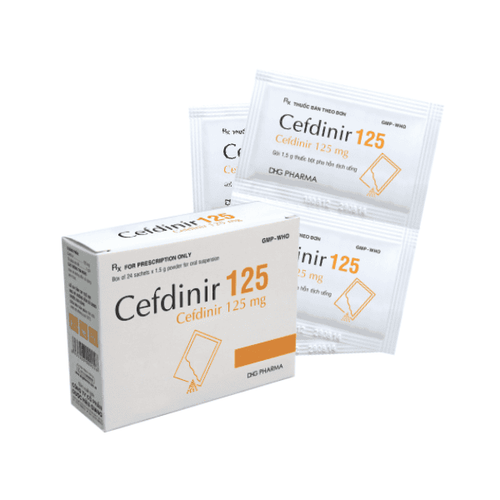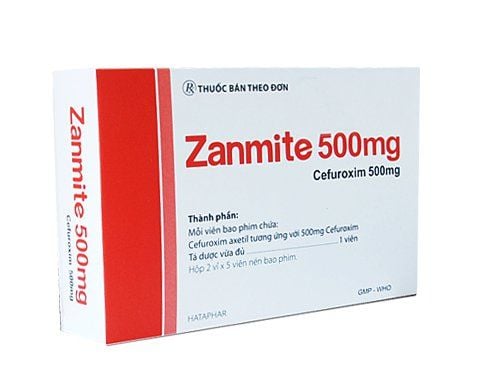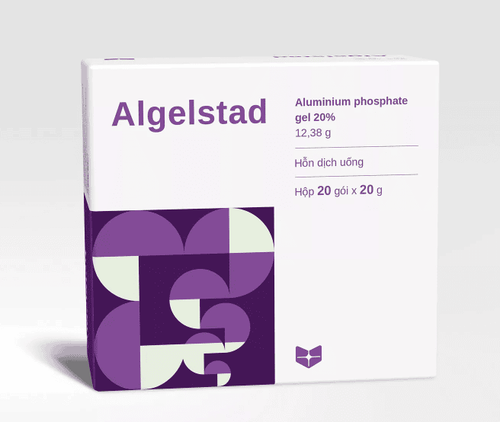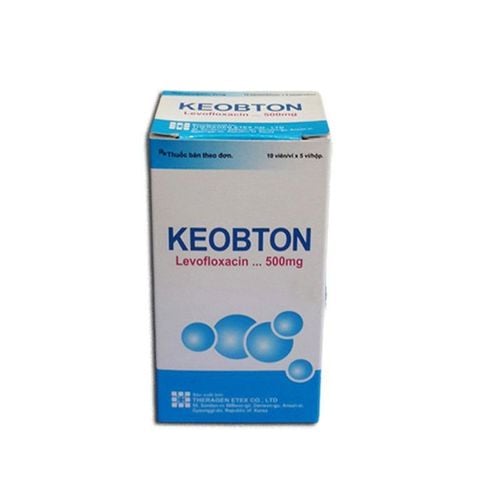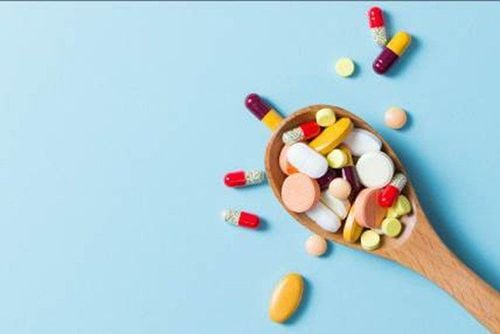This is an automatically translated article.
G fluorine 200 is mainly used to treat respiratory infections, gonorrhea, urinary tract infections,... In general, G fluorine 200 can bring good bactericidal effect, but There are still some side effects. Therefore, while taking the drug, the patient should strictly follow the instructions that the doctor has recommended.
1. What is G flo 200?
Drug G flo 200 belongs to the group of anti-bacterial, antifungal, antiviral and anti-parasitic drugs. This antibiotic is often appreciated by experts for its ability to effectively treat bronchitis and severe pneumonia caused by bacteria.
G fluorine 200 is a pharmaceutical product of Gracure Pharmaceuticals Ltd - India, prepared in the form of round yellow and 2-sided film-coated tablets, packed in boxes of 10 blisters x 10 tablets. In each G fluorine tablet contains the following main ingredients:
Main active ingredient: Ofloxacin 200mg. Other excipients are sufficient: Lactose, Talc powder, Corn starch, Hypromellose, Magnesium stearate, Macrogol, Titanium dioxide and yellow iron oxide.
2. Indications and contraindications for the use of G fluorine 200
2.1. Indications for use G flo 200 G flo 200 is generally indicated for use in the treatment of the following health conditions:
Respiratory tract infections, for example pneumonia or severe bronchitis caused by bacteria. Treatment of Chlamydia infections in the urethra or at the cervix, with / without gonorrhea, uncomplicated gonorrhea. Treatment of urinary tract infections or prostatitis. Treatment of soft tissue and skin infections. Anthrax disease. Colitis occurs due to bacterial infection. Treatment of acute infectious exacerbations of chronic bronchitis. 2.2. Contraindications to use G flo 200 Do not use G flo 200 for the following cases:
People with a history of allergy or hypersensitivity to the antibiotics of the Quinolone group, Ofloxacin or other ingredients in the drug. G flo 200 is contraindicated in patients with a deficiency of Glucose-6-phosphate dehydrogenase in the body. Because Fluoroquinolone antibacterial drugs such as Ofloxacin or Ciprofloxacin have a risk of causing cartilage degeneration in load-bearing joints, G fluorine is not recommended for use in children under 18 years of age, pregnant women or nursing mothers. breastfeeding.
3. Mechanism of action of the active ingredient Ofloxacin in G fluorine 200
The active ingredient Ofloxacin of G fluorine acts as a synthetic fluoroquinolone antibiotic similar to Ciprofloxacin, but the bioavailability of Ofloxacin when taken orally is usually higher (> 95%). According to research, the active ingredient Ofloxacin has a relatively broad antibacterial spectrum, including:Sensitive strains: Bacillus anthracis, Acinetobacter beaumannii, Staphylococcus, Campylobacter, Branhamella catarrhalis, Escherrichia coli, Citrobacter freundit, Bordetella pertussis, Klebsiella pneumonia , Enterobacter cloacae, Morganella morganii, Haemophilus influenzae, Proteus vulgaris, Proteus mirabilis, Legionella, Neisseria pasteurella, Salmonella serratia, Yersinia, Pseudomonas aeruginosa, Providencia, Vibrio, Mycoplasma hominis, Shigella. Moderately susceptible strains (Gram (+) aerobic bacteria): Streptococcus, Corynebacterium, Streptococcus pneumonia. Resistant strains: Listeria monocytogenes, Ferococcus, Nocardia asteroides methicillin-resistant Staphylococcus. Other strains: Mycoplasma Denonia, Chlamydia, Urban Luxe real ticum. In general, the active ingredient Ofloxacin in G flo 200 has a strong ability to kill bacteria by inhibiting DNA - gyrase of Gram-negative bacteria, and preventing Topoisotherse IV of many Gram-positive bacteria.
Below are the pharmacokinetic effects of the active ingredient Ofloxacin:
Absorption: Ofloxacin is rapidly absorbed from the gastrointestinal tract by the body. Bioavailability is approximately 100% after oral administration and peak plasma concentrations of ofloxacin are 1–2 hours after a 400 mg oral dose. The rate of drug absorption may be slowed by the intervention of food, however the rate of absorption is not affected. Distribution: Ofloxacin is widely distributed in all body fluids, including cerebrospinal fluid, and has good tissue penetration. It is estimated that plasma protein bound drug concentrations are about 25% (low). Ofloxacin can be excreted through the placenta and breast milk, reaching relatively high concentrations in bile. Metabolism: Less than 10% of Ofloxacin is metabolized to Ofloxacin N-oxide and Desmethyl-ofloxacin when administered in a single dose. On the other hand, the metabolite Desmethyl ofloxacin provides moderate antibacterial activity. Elimination: The major site of elimination of Ofloxacin is the kidney, about 75-80% of the drug is excreted unchanged in the urine within 24-48 hours. Only about 5% of Ofloxacin is excreted as metabolites in the urine and 4-8% of Ofloxacin is excreted by the kidneys.
4. Dosage and how to use G fluorine 200
4.1. Dosage of the drug G flo 200 Dosage of the drug G flo 200 is determined specifically based on the age and health of the patient, including:
Treatment of bronchitis or pneumonia: Oral 400mg of Ofloxacin per day 12 hours within 10 days. Treatment of Chlamydia in the ureter and cervix: 300mg Ofloxacin every 12 hours for 7 days. Prostatitis: Take 300mg of Ofloxacin every 12 hours for 6 weeks. Treatment of uncomplicated gonorrhea or gonorrhea: Take a single dose of Ofloxacin 400mg. Treatment of inflammation caused by K. pneumoniae or E.Coli: Oral 200mg Ofloxacin every 12 hours for 3 days. Treatment of cystitis caused by other bacteria: 200mg Ofloxacin every 12 hours for 10 days. Dosage of G flo 200 can be adjusted for patients with impaired renal function based on creatinine clearance, specifically:
Creatinine clearance above 50ml/min: No dose adjustment, orally every 12 hours for one dose. Creatinine clearance 10 - 50ml/min: No dose adjustment, one dose every 24 hours. Creatinine clearance less than 10ml/min: Take 1/2 normal dose, once every 12 hours. For patients with cirrhosis should take G fluorine 200 not to exceed 400mg/day.
4.2. Instructions for using the drug G flo 200 Before using the drug G flo 200, patients should carefully read the instructions for use of the drug or strictly follow the instructions of the doctor, including:
Take the medicine with filtered water due to the medicine. formulated in the form of tablets. Patients may drink extra fluids to keep kidney function working properly. Take Gflo 200 with/without food, preferably at the same time of day to avoid missed doses. Avoid sharing G fluorine with other people.
5. Some side effects of G fluorine 200
Patients should get emergency medical help if signs of an allergic reaction (difficulty breathing, rash, swelling of the throat or face) or a serious skin reaction (sore throat, fever, skin pain, skin redness, burning in eyes, cyanosis, rash or peeling, blistering). According to research, the use of G fluorine 200 can cause a number of dangerous side effects, including nerve damage, tendon problems, behavioral changes, mood swings or blood sugar levels. Low blood pressure leads to coma.
Common side effects of G fluorine 200 include:
Nausea. Constipation . Diarrhea. Dizzy. Headache. Stop using Gflo 200 and tell your doctor if the following signs occur:
Low blood sugar, symptoms such as hunger, sweating, headache, dizziness, irritability, fast heartbeat, nausea, tremors, or anxiety. Nervous system effects in the arms, hands, legs/feet such as burning pain, tingling and weakness. Severely altered mood or behavior, including agitation, confusion, anxiety, hallucinations, paranoia, difficulty concentrating, memory problems, suicidal thoughts. Signs of tendon rupture, including swelling, sudden pain, stiffness, bruising, problems with movement, and a clicking sound in the joints. Causes damage to the aorta, resulting in bleeding/death. Bloody diarrhea, severe abdominal pain. Fast heartbeat, pounding heart, shortness of breath, fluttering feeling in the chest, sudden dizziness. Muscle weakness or difficulty breathing. Convulsions. Little/no urinating. Increased pressure in the skull, ringing in the ears, severe headaches, pain behind the eyes, or vision problems. Have liver problems such as loss of appetite, upper abdominal pain, clay-colored stools, dark urine, jaundice.
6. Things to keep in mind when using G fluorine 200
6.1. What precautions should be taken when using G flo 200 drug During the use of G flo 200 drug, patients need to be careful about the following things:
Patients with renal failure or the elderly need to take the drug with caution, can be careful dose reduction reminder. Use G fluorine with caution in patients with liver failure. If the patient feels dizzy after taking the drug, the patient should not operate machinery or vehicles. Discontinue use immediately if any signs of hypersensitivity appear. During the use of G fluorine, patients need to drink a lot of water, avoid exposure to UV rays from the sun. The drug should be used with caution in patients with epilepsy or a history of CNS disorders. The activity of Ofloxacin against Mycobacterium tuberculosis may change the BK test result to a negative in patients with osteosarcoma or pulmonary tuberculosis. 6.2. Interactions of G flo 200 with other drugs Some medicines when taken with G flo 200 can make them less effective. If you are taking any medicine or other substance, it is best to take the dose of G fluorine 200 about 2 hours before/after taking the following:
Antacids containing magnesium, calcium and aluminum, eg Milk of Magnesia, Amphojel, Di-Gel Maalox, Pepcid Complete, Mylanta, Tums, Rulox, Rolaids; or the ulcer medicine Sucralfate (Carafate). Didanosine (Videx) is a chewable tablet or powder. Additional vitamins or minerals such as iron, calcium, zinc or magnesium. Theophylline, diuretics, blood thinners (Coumadin, Jantoven, or Warfarin). Diabetes medication or insulin. Medicines to treat arrhythmias. Medicines for depression or mental illness. Steroids (Prednisone). Non-Steroid Anti-Inflammatory Drugs such as Ibuprofen, Aspirin, Naproxen, Diclofenac, Celecoxib, Meloxicam, Indomethacin,... The above are drugs that can interact with G fluorine 200. There are still some other drugs. may also affect G fluorine drugs, including over-the-counter medicines, natural herbal products,...
Please dial HOTLINE for more information or register for an appointment HERE. Download MyVinmec app to make appointments faster and to manage your bookings easily.





